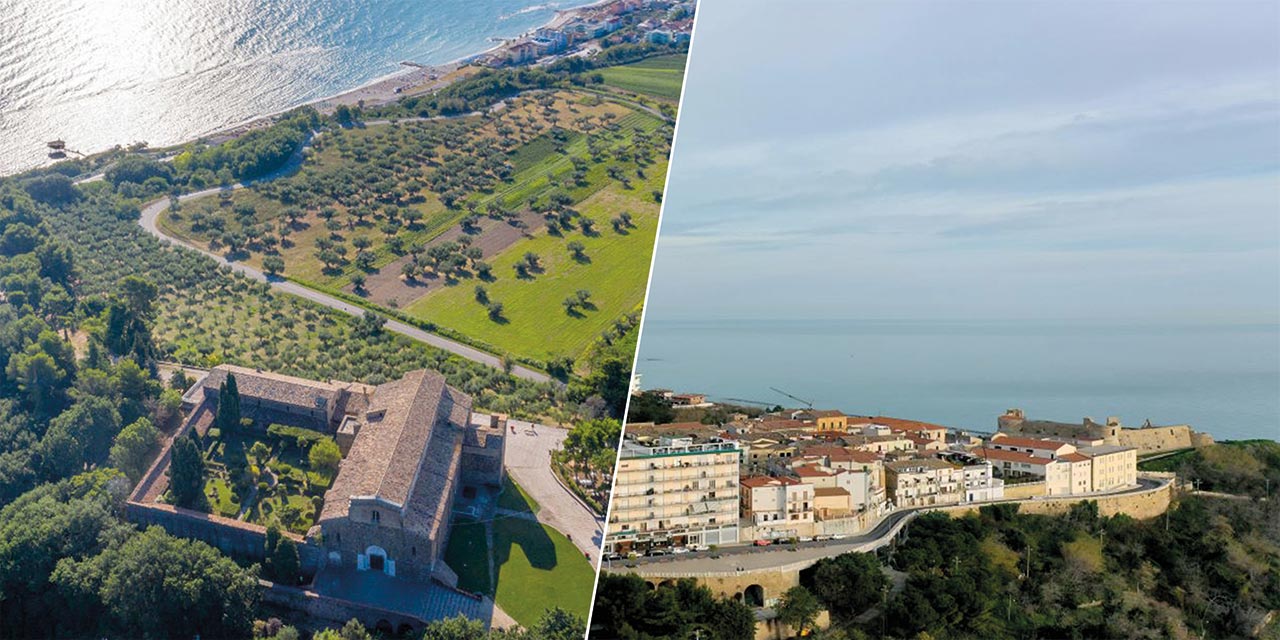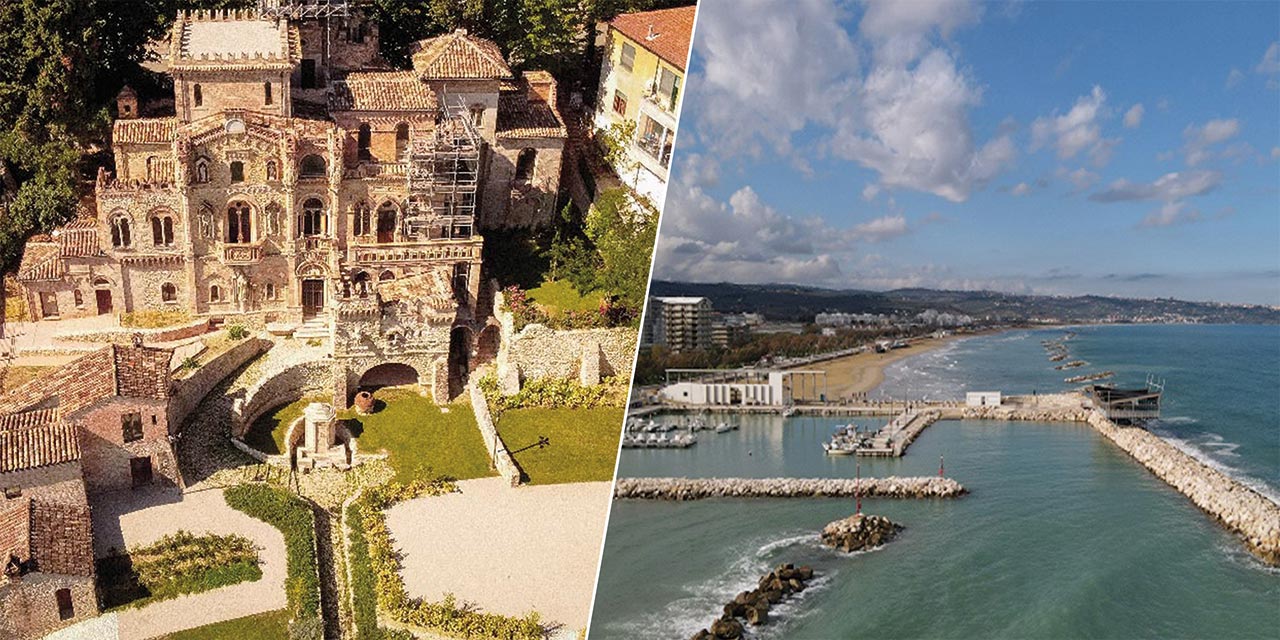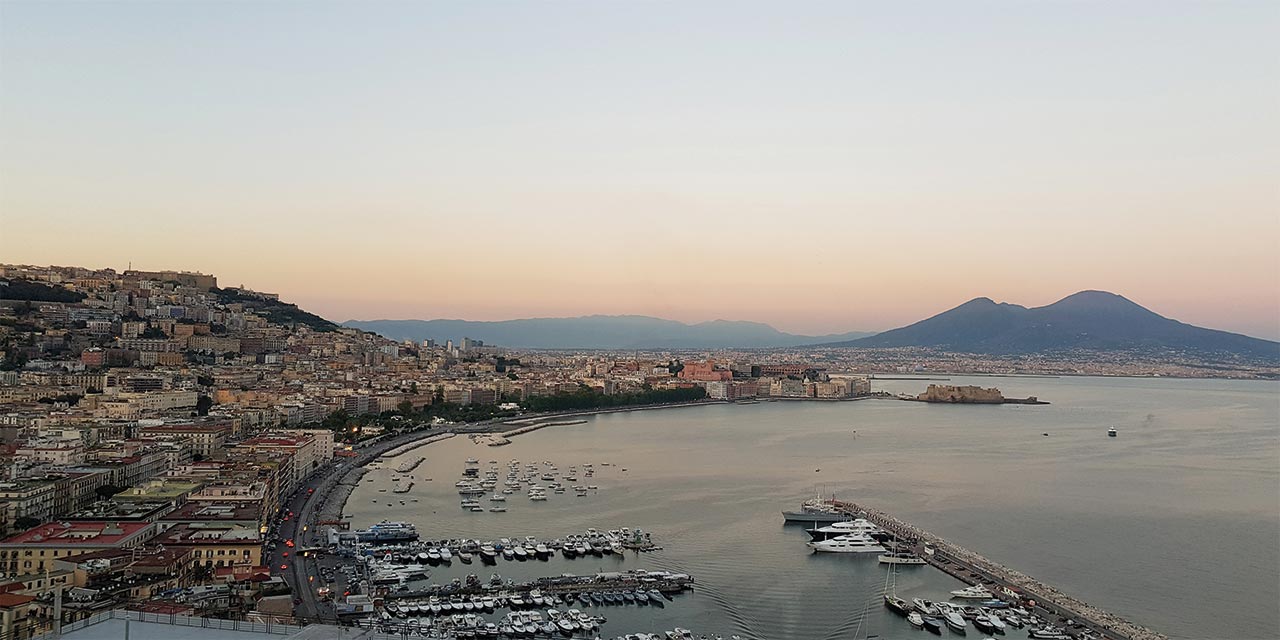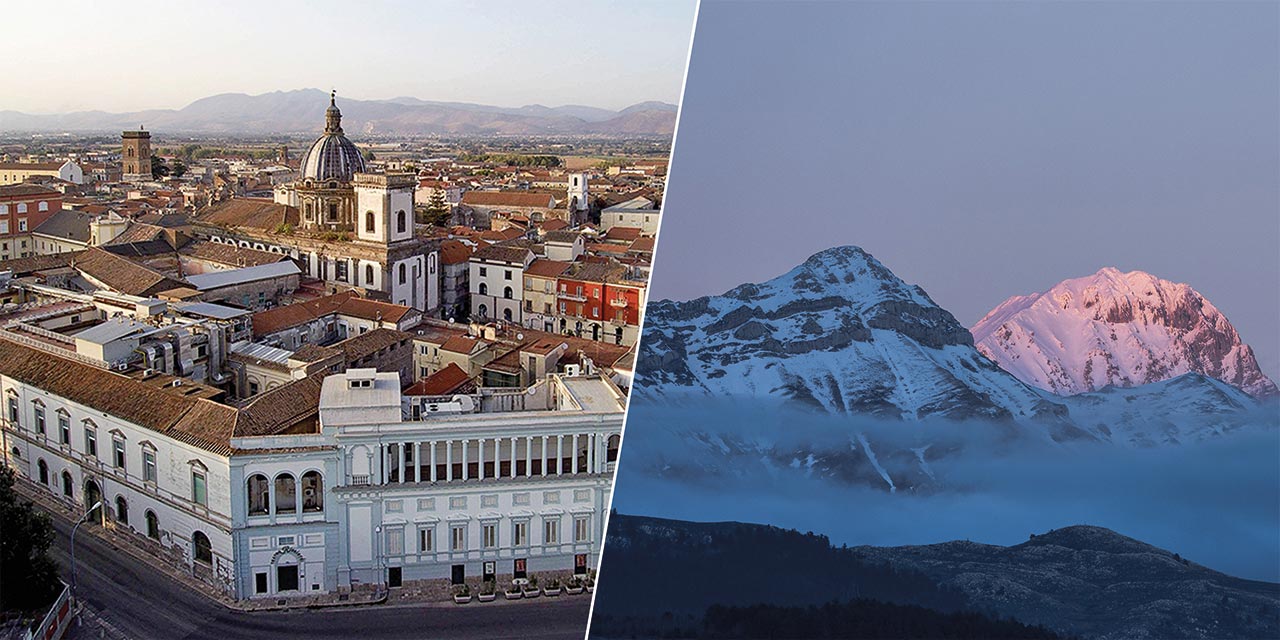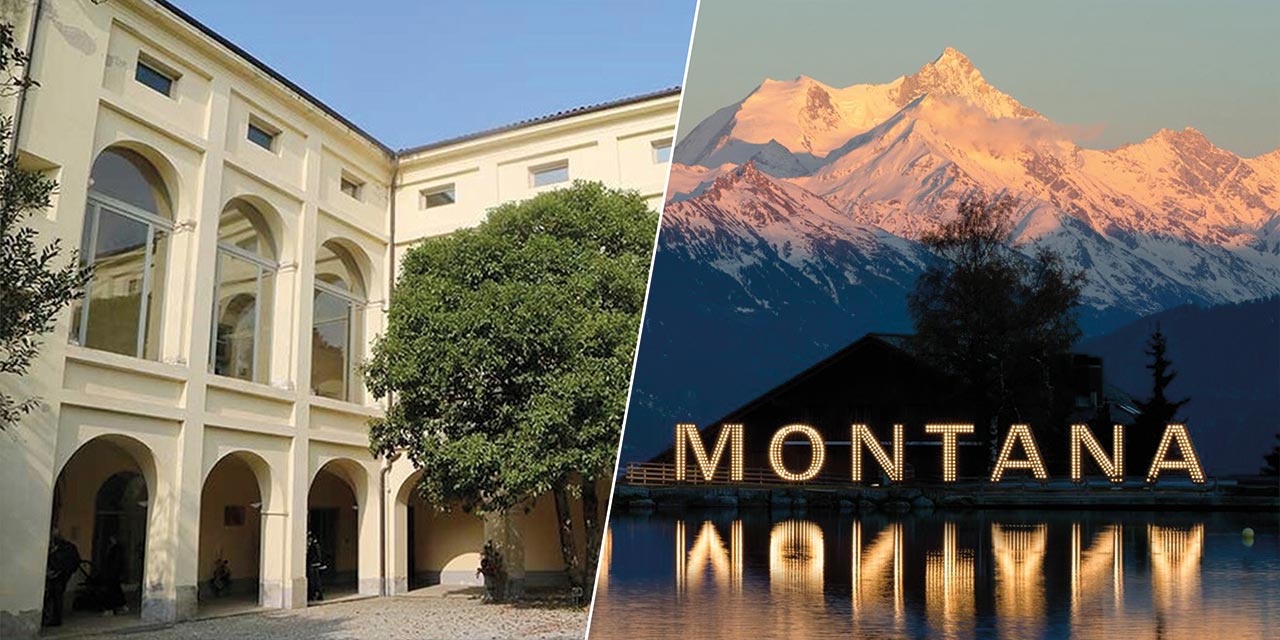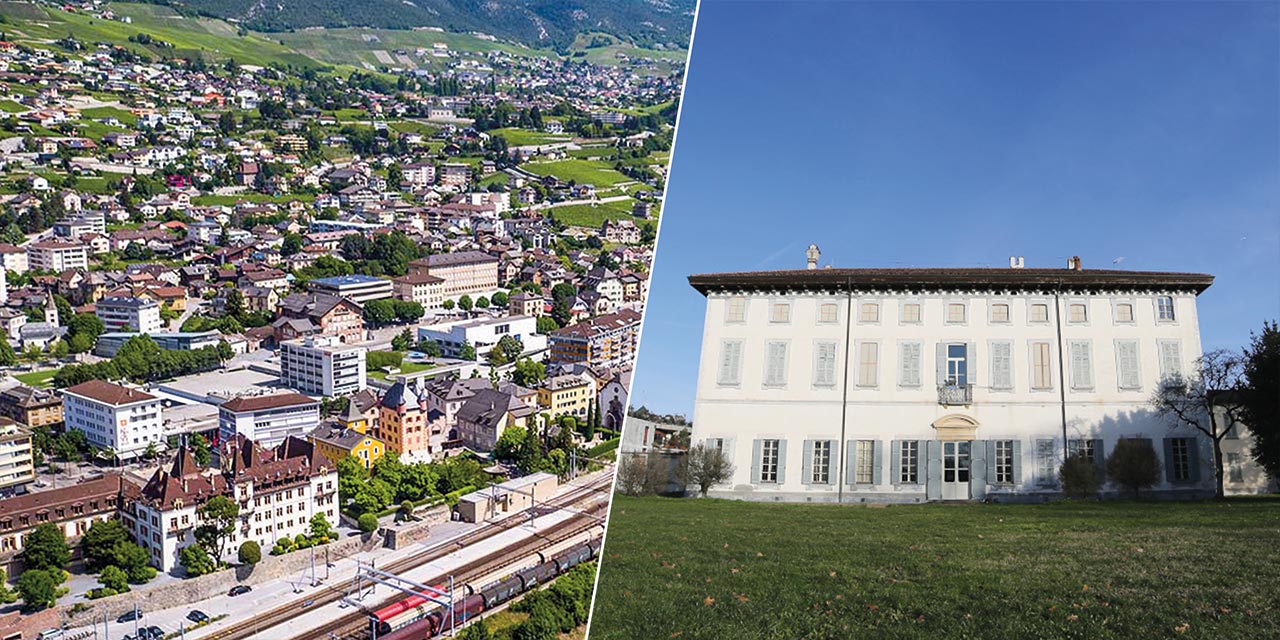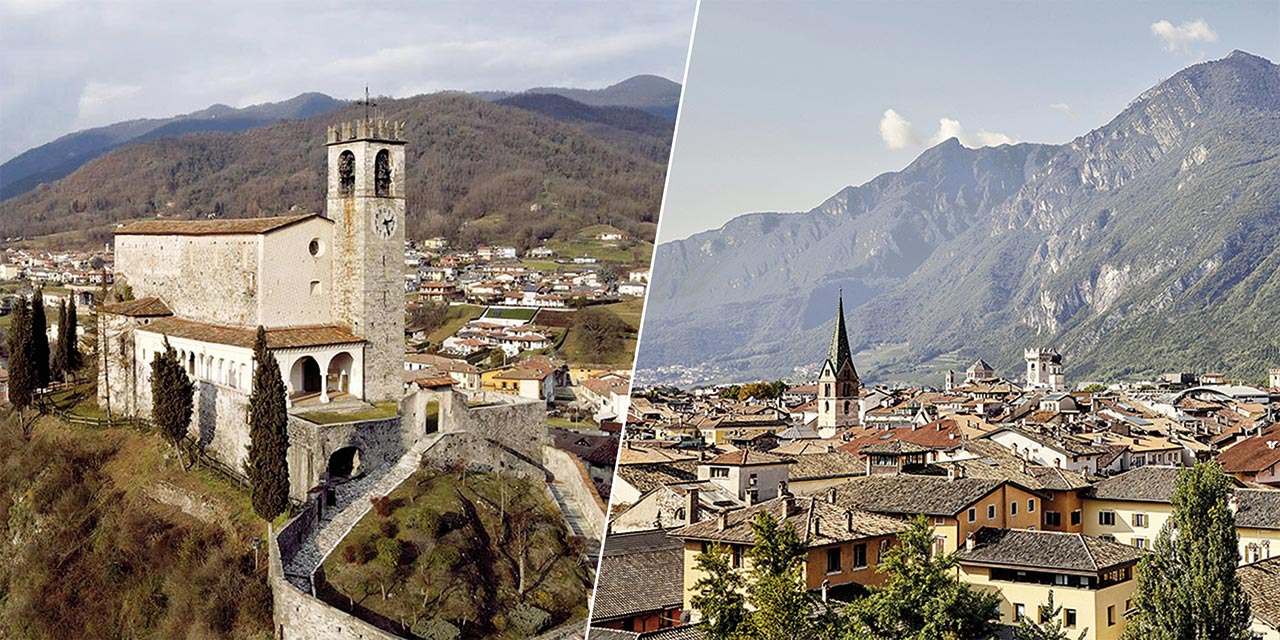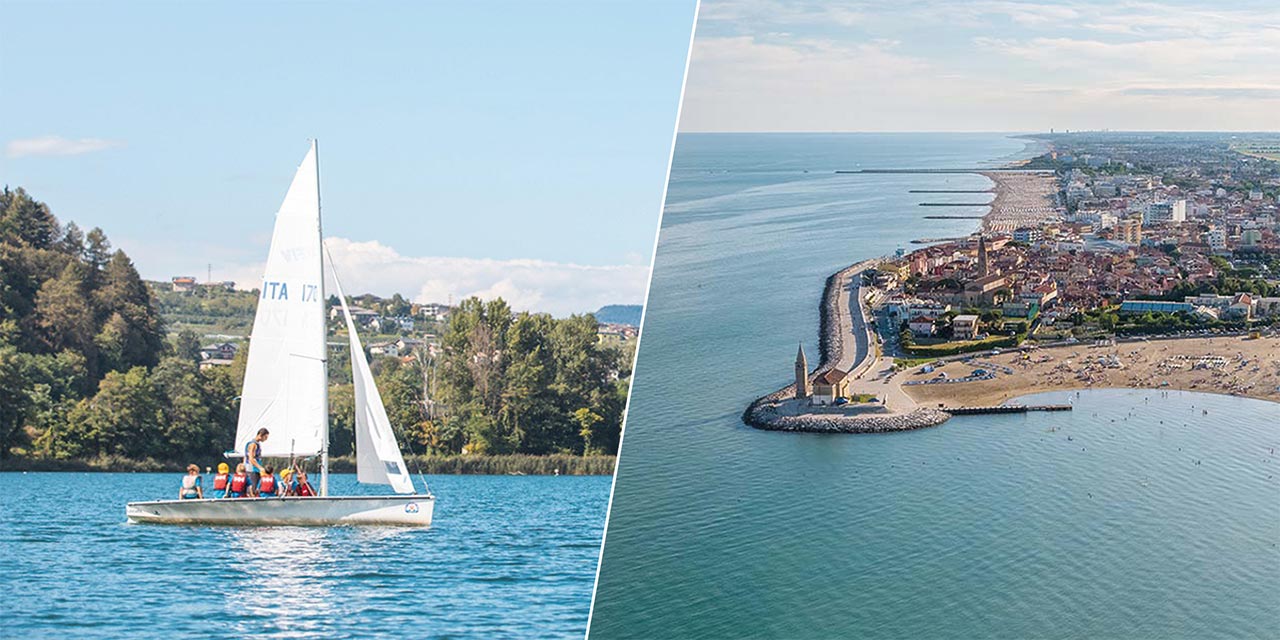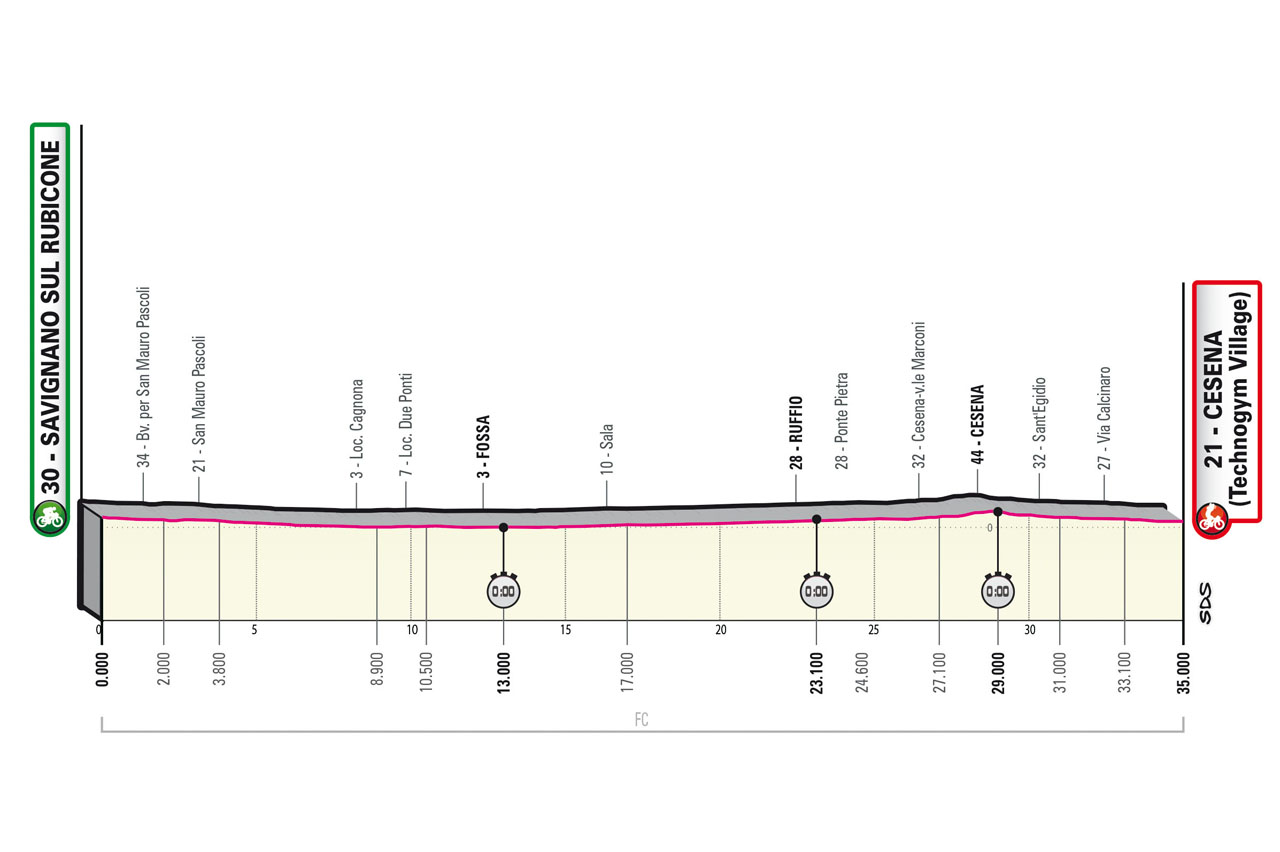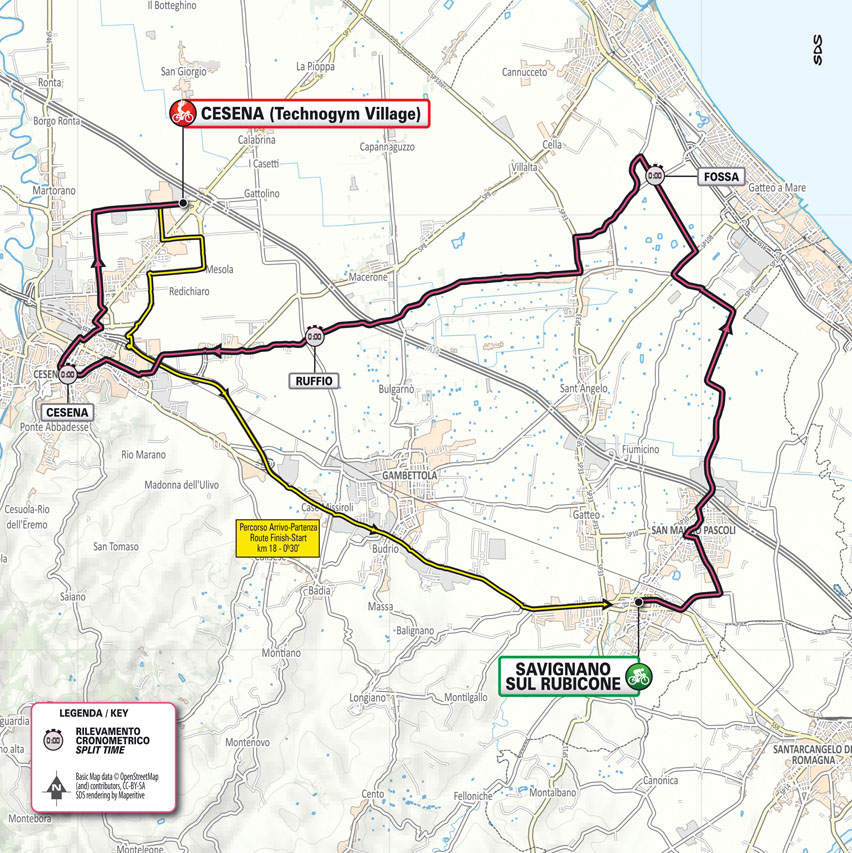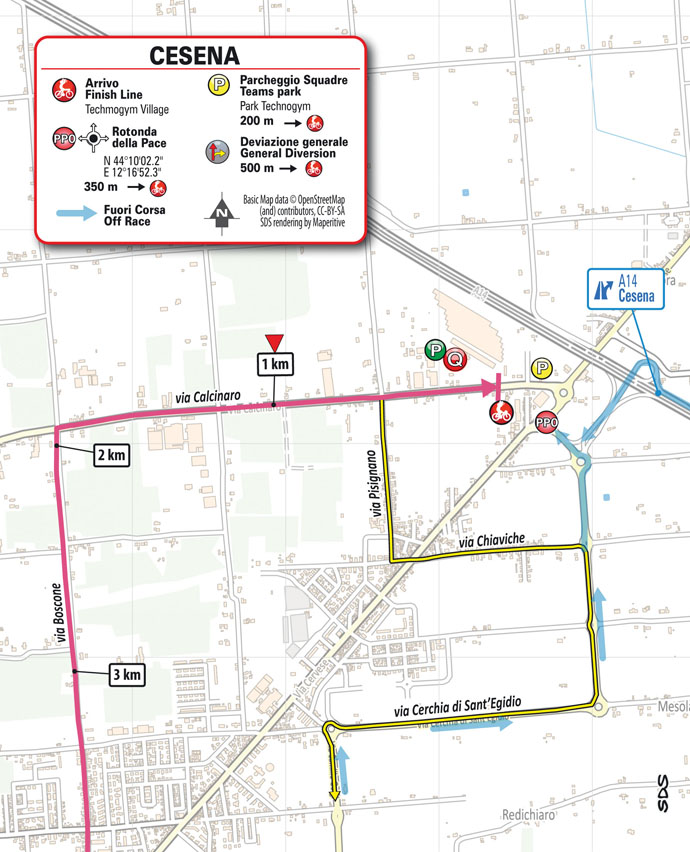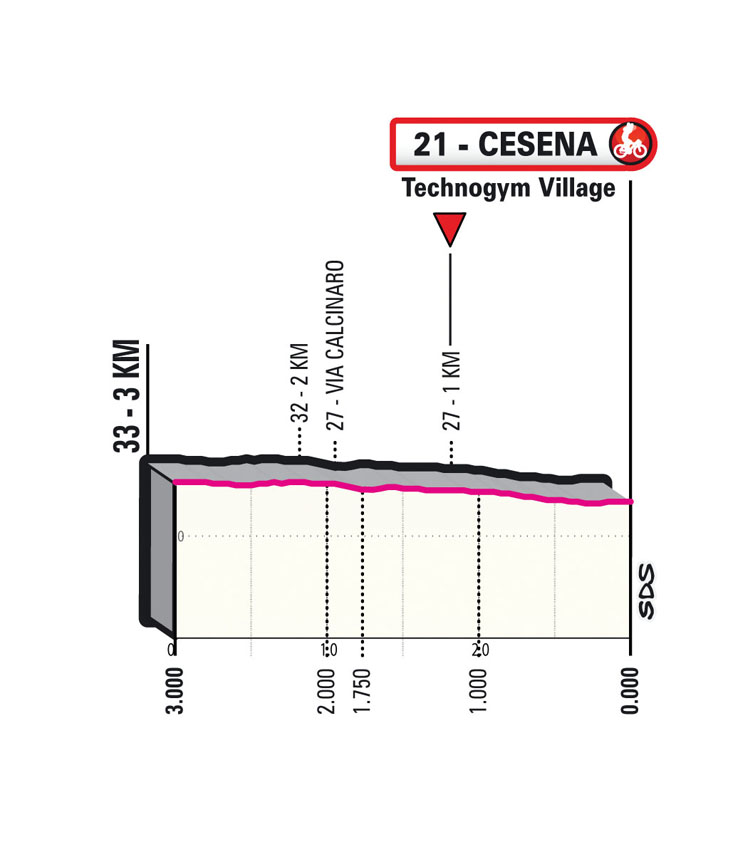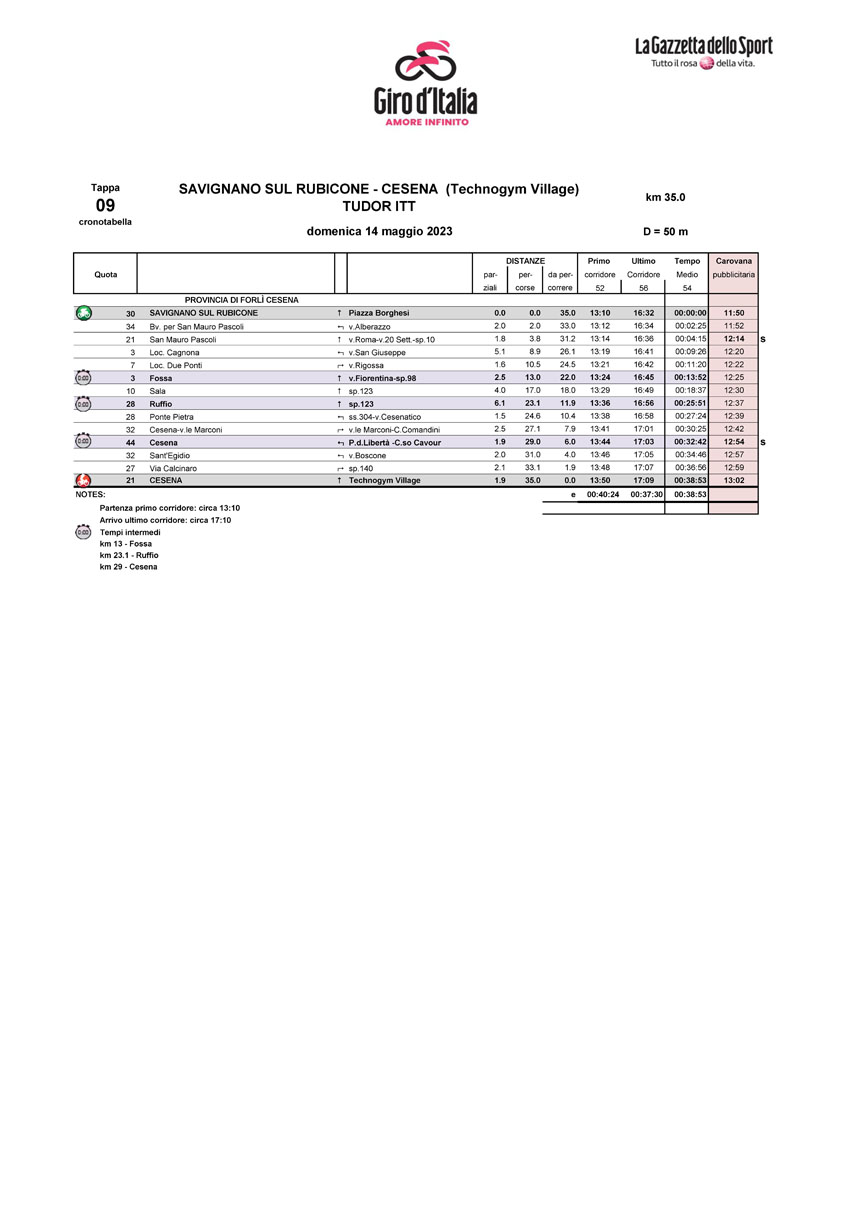profile
map
technical info
A perfectly flat ITT, raced mostly on wide and well‑paved roads with only a few bends. The roadway narrows at points when travelling across the urban areas of San Mauro Pascoli and Cesena, and there is a short stretch of porphyry in Cesena. The route is flat and straight in the stage finale.
Final kilometres
Past urban Cesena, the final 3 km are pan‑flat and straight, with just one bend 1,900 m before the finish. The home straight (1,900 m) is on 7 m wide tarmac.
start / finish
final kilometres
itinerary timetable
tourist info
Host city:
Savignano sul Rubicone
Overview
Savignano sul Rubicone, a small town of about 18.000 inhabitants, lies halfway between the Adriatic coast and the hills in the hinterland of Romagna. The village is 13 kilometres far from the sea, but part of its territory stretches along the coast with a small sandy beach of 240 metres.
Its first settlement dates back to the Roman period. It was a little village in the town quarter “Compito”, at the crossroad between the ancient route Emilia and another route connecting the Apennines to the sea. The Roman bridge, which dates back to the 1st Century A.D, the museum and the near archaeological site witness still nowadays the origins of the town.
Culture, popular traditions and photography are the main aspects of an identity deeply anchored in its past. Thanks to the Rubiconia Accademia dei Filopatridi, preceded during the 17th Century by the Accademia degli Incolti, there has been through the centuries a wide literary activity so that the town has been named by George Byron “The Athens of Romagna”.
Savignano sul Rubicone is also considered to be the cradle of the ballroom dance music of Romagna. If you wish to get to know more about this music just visit the Liscio@Museum, a virtual research centre on music and traditional dances. Every year since 1992 the city hall also organizes the SI FEST, the most long-running photography festival in Italy. Thanks to it the town has conquered a considerable role in the field of photography, universally known as the most modern language of the new millennium.
Food
Savignano sul Rubicone fears no competition at table, especially for two prestigious products that alone are worth a visit: wine and cheese. The first combines the pleasure of taste with the beauty of the landscape along the Savignano – Sogliano road, the legendary Nove Colli bike route, which then continues up to the hills offering amazing views over the Adriatic sea and the Apennines. Along the road on the Ribano hill a unique castle, bearing the same name of the place, stands out on the horizon. This fortified building of the medieval age, surrounded by ancient vineyards and rich olive trees, is home to the Spaletti Colonna di Paliano Winery, which continues a thousand year old tradition of grape and wine production in this area. As early as the 16th Century the wines of Ribano refreshed the Classensi Monks holidaying at the castle. Since then the art of making good wines has been handed down within the Spalletti Colonna di Paliano noble family and has remained unchanged until today. Prince Giovanni Colonna di Paliano is the current owner of the castle. He expanded the vineyard cultivations and in 2005 a new high tech wine cellar has been inaugurated where extraordinary wines are produced. The most popular among them are Sangiovese, Albana, Bombino Bianco, Cabernet Sauvignon, Franc Riesling, Chardonnay and Merlot. These fine wines can be purchased in the castle shop or tasted on site during a visit to the castle and the ancient and modern cellars.
The second most famous delicacy of Savignano is the soft cheese “Squacquerone” DOP, produced by the dairy Caseificio Pascoli. Founded in 1964 thanks to Cav. Michelino Raduano along the banks of the historic river crossed by Julius Caesar, this cheese factory has been run by expert cheesemaker Marinella Conti for over thirty years. In addition to the many fine cheeses, valorised and rediscovered over the years thanks to research and various studies, the production includes the extraordinary “Squacquerone of Romagna” DOP and the “Fossa” DOP cheeses matured in the medieval, cone-shaped pits of this area. The farm shop is open to the public. It is a must to taste these local cheeses together with “piadina romagnola”, which is a flat, round bread to be found at the numerous stalls spread around the town and open all day long, because “piadina romagnola” can be enjoyed at any time, even at breakfast with plenty of Nutella. The only dilemma for those who decide to stop over in this delightful land between the north and the south of Italy is whether to choose “piadina sfogliata” in the Rimini style or “piadina alta” in the Cesena style. Either way it will be a tasty home-made, artisanal product nowhere else to be found.
Lovers of good food cannot miss a visit to the Biofrutta Farm not far away from the Roman site “Compito”, the ancient Compitum, and the fascinating Don Franchini Archaeological Museum. In addition to the possibility of going for marvellous walks in the organic wood and wonderful tastings of seasonal products, owners Lilly and Sanzio offer their tourists fascinating tours in their 12 hectares of entirely organically farmed Romagna countryside.
Also popular in this area is the great quality choice that Savignano sul Rubicone offers in terms of catering with “trattorias”, inns and restaurants offering fish specialities, traditional delicacies of Romagna and simple dishes of the day as well as modern reinterpretations, that can be tasted with a choice of top wines to be found in specific shops in town as well as in some others specialised in gourmet proposal.
Points of interest
History, ballroom dancing, photography.
These are only three of the many reasons to stop at Savignano sul Rubicone, a little town in Romagna lying along the most famous river in the world, the Rubicon. Its importance is strictly linked to an extraordinary and unique historical event: it was crossed by the armed Julius Caesar in 49 B.C. on the cry of Alea iacta est. This little river marked the border between the territory of Rome and the cis-alpine Gaul from 89 to 42 B.C, but most of all it was the boundary that Caesar violated when he challenged the law of Rome, and, by doing so, he set off its future destiny as a glorious empire, determining in this way the fate of the world.
The evocative, impressive Roman bridge over the river, which was built in the 1st Century A.D., and then rebuilt after the wartime events of 1944 by employing the original stones, together with the historical figure of Julius Caesar and the Rubicon itself, still today represents the symbol of a worldwide known event eternalized in the poetry of Dante and of Pascoli, in the prose of Boccaccio and by the many travellers who have left a testimony in their reports.
Next to the bridge is a statue of Julius Caesar, a perfect copy of the one standing in Rome at the Campidoglio.
Also worth visiting is the Archaeological Museum “Don Giorgio Franchini” in the neighbourhood of “San Giovanni in Compito”. Thanks to the many archaeological finds we know that this area has been populated since the Roman republican period. Also, noteworthy is the near Romanesque parish church, one of the most ancient and finest buildings of this area.
Savignano sul Rubicone, a thriving centre of cultural activities, is also known as the “Athens of Romagna”, because of the large number of scholars, intellectuals and archaeologists who have been part and still are of the “Accademia Rubiconia dei Filopatridi”, one of the most prestigious academies of Romagna dating back to the 17th Century and which is still open and can be visited. In its library you can find more than 60.000 volumes made up of manuscripts, incunabula and cinquecentine (16th Century books).
Not far from the town centre, on the Ribano hill, it is possible to visit the medieval castle carrying the same name as the hill. It is the seat of a thousand-year-old cellar which produces prestigious wines. You can visit both the old cellar and the new one, built in 2005 and equipped with the most modern technology. The castle lies along the Savignano-Sogliano road which is part of the cycling route “Nove Colli”, a world famous bike race that takes place every year in May. From this hill you can enjoy beautiful views that stretch out between the sea and the Apennines.
Several villas represent other stop-overs of this real journey into beauty: Villa “la Rotonda” owned by the marquises Guidi Di Bagno, Villa Perticari, Villa Rasponi, Villa Bilancioni and Villa Secondo Casadei that, together with the nearby record company Casadei Sonora, has gained the right to enter the prestigious list of more than a hundred “Case della Memoria” (Memory houses) in Italy. The Maestro Secondo Casadei is the founder of the so called “liscio romagnolo” the typical ballroom dance of this area and the author of the famous song “Romagna mia”. In the record company Casadei Sonora you can admire musical instruments, scores, vintage pictures and records, awards, dresses and memories of a fifty-year long and successful career. It is also possible to visit the studio of the Maestro in the nearby house where he lived from 1957 to 1971.
In the historical centre Palazzo Vendemini, the Monte di Pietà, the “Vecchia Pescheria” (Old Fish Market), Palazzo Martuzzi and the Municipal Palace complete the architectonic patrimony of the town together with eight religious buildings among which the most interesting and famous are the 18th Century Collegiate Church of Saint Lucy on the main square and the Sanctuary of Our Lady of Grace (Madonna delle Grazie) in the neighbourhood of “Fiumicino”.
Savignano sul Rubicone is also known as the “Town of Photography”, and seat of the SI FEST, the most long-running photography festival in Italy, which takes place every year in September since 1992. During the festival the town hosts expositions and the most accredited photographers in the world are invited to partecipate. Inside the Public Library, which is open to the public, you will find a considerable number of photographic archives, and one that is made up of the entire artistic patrimony of the reporter Marco Pesaresi.
Cesena
Overview
Nestled in the Savio River Valley, a few kilometers from the sea, the city of Cesena is an important art destination, known for good food and a thriving economy, especially in agriculture, and for being the city of Wellness. In fact, in Cesena, cultural tradition goes hand in hand with hospitality and living well. Known for being the City of the Three Popes, but also the cradle of Sport and two wheels, as a promoter in good practices of sustainable mobility and is included in the Grand Tour of the Savio Valley. The city is characterized by a very lively center, marked by a cuisine firmly anchored in the traditions of Romagna along with beign a modern and dynamic university hub that attracts more than 5 thousand students.
Cesena is also the city of the Malatestiana Library, the only example left in the world of a humanistic library perfectly preserved in its building, furnishings and it’s contents. Rising within the Franciscan convent at the behest of Malatesta Novello, it is today a splendid example of a monastic-Renaissance library, which has remained intact in every part due to the joint custody of the friars and the Municipality; it preserves the original furnishings and an important collection of illuminated codes, as recognized by Unesco, including it, first in Italy, in the Memoire du Monde program. During the rule of the Malatesta family (1378-1465) Cesena experienced an era of magnificence, capable of giving the city the present face that it still preserves today, despite the passage of time. It was the latter who designed the town with the walls, which are still preserved in their entirety, but above all, they engaged in the rebuilding of the Rocca, which, from the top of the Garampo hill, dominates the entire city, confirming itself as one of the best-preserved large fortifications in all of Romagna and one of the most appreciated by Leonardo Da Vinci.
In recent years Cesena has begun implementing the strategic vision of “Cesena Sport City”, a plan to promote inclusion through sport by combining motor activity and wellness. Cesena is an attractive year-round destination. Many important events take place here, including the very old and traditional St. John’s Fair on June 24, Piazze di Cinema in July, the highly popular International Street Food Festival in the first weekend of October, the Medieval Joust and the Acieloaperto concerts followed up by a slew of in open-air locations, with theater festivals and music nights, the winter calendar at the “A. Bonci” Theater by Emilia Romagna Teatro ERT/Theater Foundation, and the international trotting races at Ippodromo del Savio.
Food
Cesena, thanks to its rich Romagna traditions, has plenty to offer to those who are looking to dip in traditional dishes.
When, between a cultural visit and a walk in the center, it comes time to go to the table, you can choose a typical Romagna restaurant, a bistro, an osteria or try street food. In fact, the International Street Food Festival was born here in 2000, becoming a periodic event that is always highly anticipated and attended. And street food of excellence is the piadina romagnola, called ‘la pida’ in dialect.
It is a kind of disc of unleavened bread, often eaten in the characteristic kiosks, and accompanied by different fillings such as squacquerone (typical fresh and creamy cheese) and rocket salad, or by local cold cuts.
The crescione, on the other hand, is an elaboration of the piadina folded in half and stuffed before cooking. The herb one is the most common, but there are many types. The piadina must be kneaded strictly by hand and rolled out with a rolling pin. It is cooked on the testo (‘teggia’ in dialect), which is a red-hot terracotta or cast-iron griddle. But it is not enough to put together the right ingredients to produce an excellent piadina: also very important is the thickness, which often reveals the precise area of production. In Cesena the piadina is medium thick while, for example, in the Rimini area it is thinner.
From piadina to pasta dishes: a continuous trundle of goodness! Not everyone knows that there is no term “pasta” in the Romagnolo dialect: the homemade pasta dishes of Romagna cuisine, whether in broth or dry, and by extension all first courses, are called mnestra (“soup”). “Mnestra sòta” (dry) and “mnestra int e’ brod” (in broth). Unlike other parts of Italy where “minestra” is exclusively a liquid dish.
Traditional soups in Cesena include those made with egg pasta sheets (tagliatelle, lasagna, passatelli asciutti or in broth, tagliolini, maltagliati), those with eggless pasta sheets (strozzapreti, pappardelle in broth), and stuffed pasta such as cappelletti (traditionally, the family meets on Christmas Eve to prepare them for the holidays) and tortelli.
Cesena’s fruits and vegetables, then, are a national pride. Crops include peaches, apricots, plums, Romagna strawberries, kiwis, apples, pears, and several distinctive varieties of cherries. Prominent among vegetables are potatoes, green beans, peas, lettuces, chicory, turnips, tomatoes, giant Romagna thistles, and violet Romagna artichokes.
Some of these crops are still in full production, while others now represent local or niche productions such as the Romagna shallot, which has been awarded the IGP label.
Moreover, Cesena is in a privileged geographical location: in addition to being just a few kilometers from the Adriatic Riviera and along the Via Emilia, it is at the gateway to the Savio Valley. Valuable and fascinating localities are promoted together under the brand ‘I Percorsi del Savio’ (www.ipercorsidelsavio.it). They are Cesena, Montiano, Mercato Saraceno, Sarsina, Bagno di Romagna and Verghereto. Here, local flavors and aromas are enriched with mushrooms, truffles, and chestnuts. Taste and tradition links that make Cesena and Romagna a land of hospitality and well-being.
Wine and beverage
On the tables of Cesena, as well in the whole of Romagna, wine is widely present, called precisely ‘e be’ (drinking). Sangiovese, albana, pagadebit, trebbiano and cagnina are the protagonists of the barrels, cellars and hills of Cesena.
Points of interest
Biblioteca Malatestiana
The splendid Renaissance library (1447-1452) was commissioned by Malatesta Novello to M. Nuti for the old Franciscan convent. The original structure with its furnishings and its important collection of illuminated codices is wholly preserved thanks to the care of the friars and of the city counsellors. The Malatesta Library is the only example in the world of Humanistic Library perfectly preserved in the building, in furnitures and book equipment , as recognized by UNESCO in 2005, by inserting it into the Memory of the World Register.
Rocca Malatestiana
The fortress is located in the town centre of Cesena, very close to Piazza del Popolo. It rises at the top of the Garampo hill and is surrounded by the Parco della Rimembranza (Remembrance Park). This impressive fortress is characterized by panoramic battlements and striking walkways built within the curtain walls. The court also hosts a citadel that includes two imposing buildings, the Main or Male tower (Mastio), where some genuine tournament armours and saddles that were used for the Giostra d’incontro are exposed, and the Palatium or Female tower, were the Museum of Agricultural History is located. The construction works of the stronghold started in 1380 with Galeotto Malatesta, and continued with his successors Andrea and Novello Malatesta, the fortress was entirely renovated and completed in 1477 during the papal dominion. The fortress is part of a much larger fortification system that surrounds the town, a system that fascinated Leonardo da Vinci when, in the summer of 1502, he stayed in Cesena to inspect and overhaul the conquered jurisdictions forts and improve the town defence, upon request by Cesare Borgia. Some of his drawings of the Fortress (the walls of the Rocca Vecchia and the Rocca Nuova, and the Rastelli – the stockade and the main gate, the complete evaluation of the town walls, his notes on the customs and traditions of Romagna recorded on his notebook, are kept at the library of the institute of France in Paris.
Teatro “A. Bonci”
It is one of the main Italian historical theatres. It was built between 1843-1846, a project by Vincenzo Ghinelli, with a neoclassical facade recalling Piermarini and an interior with 4 grounds and gods, whose decoration is due to Francesco Migliari. The stage is one of the gratest in Europe, the acustic is quite perfect: this made the ‘Bonci’ very appreciated to actors and singers.
Palazzo del Ridotto
It is the main civic palace of the town and was erected between 1401 and 1403 (then enlarged between 1466 and 1472). It hosted the civic meetings (the ancient name ‘Conservato’ derives from the organ of the Conservatori). From 1722 the palace became meeting-point of the nobles of Cesena (meeting=’Ridotto’), who remade the façade in neoclassical style (Cosimo Moreli, 1782-87) in honour of pope Pious VI Braschi. Amazing the great bronze statue of the pope (F. Calligari, 1791).
L’Abbazia di Santa Maria del Monte
The Abbey of S. Maria del Monte is placed on Colle Spaziano, 10 minutes away from the centre of Cesena. The structure is mostly dating back to the Renaissance, even if the origins of the monastery are millennial. Among the several pieces of interest, the collection of votive tablets (ex-voto) stands out for its importance, with pieces dating back from the XV century to today.
Villa Silvia-Carducci
The History of Villa Silvia started in the 1874 when it became property of the Countess Silvia Pasolini Zanelli, who managed to made it out the parlor of the culture of Romagna. Some of the most famous intellectuals of Romagna attended the Villa: the writers Nazareno Trovanelli, Antonio Messeri, Paul Amaducci; musicians such as Balilla Pratella, Achilles Turks, Federico Sarti, the famous opera singer Alessandro Bonci and especially Carducci, which remains today, in the Villa, his bedroom, remained intact.In the evocative “Literary Garden” located around the villa, the visit is accompanied by an audio commentary that provides news, information, anecdotes and songs about the life of the countess and her relationship with Carducci and other intellectuals who frequented the house.Villa Silvia is now home of the AMMI (Italian Association of Mechanical Music), which develops the research, study, dissemination, preservation and restoration of mechanical musical instruments, with a rich library. Also, is headquartered in the villa, the museum “Musicalia”, permanent exhibition of musical instruments of extraordinary interest.
Technogym Village
The Technogym Village, created in 2012, reflects the vision of Nerio Alessandri, founder of Technogym, who, together with his brother Pierluigi and architect Antonio Citterio, conceptualised a place where lifestyle, quality, design and productivity are all combined. It is the first example of a Wellness Campus in the world that includes Technogym HQ, Research and Innovation Center, production facility and a huge wellness center open to all stakeholders – fitness operators, trainers, doctors, institutions, media – to experience firsthand Technogym wellness experience. Technogym Village is also a prototype of an healthy workplace: Technogym team members can take part in a Corporate Wellness program that includes corporate gym, healthy restaurants, sport programs, medical check-up and health services.
Stadium
The Orogel Stadium “Dino Manuzzi” has a capacity of 24,000 seats, all seated and covered, arranged on two superimposed rows of grandstands. The Stadio Comunale di Cesena was the first entirely covered Italian stadium, designed with the highest safety standards, of modern conception, comfortable and economical, where the view of the match is optimal both from the separate grandstand and from the two curves, a stadium without a track of athletics and therefore with the public in direct contact with the players, creating an atmosphere of strong impact for the fans. The central location of the stadium and the peculiarity of the environment that surrounds it due to the presence of numerous commercial activities, the location between residences and school buildings, as well as the proximity to the railway station, meant that the project was not limited to interventions on the viability, functionality and safety of the work, but rather adopt a modern concept of the stadium which envisages its use not only for football, but also for a more social use at the service of the city, and therefore for better integration into the urban fabric , of which it constitutes one of the elements emerging from the skyline of the city of Cesena.
Bicipolitana
Cesena is the third-largest city in Italy in terms of the number of kilometers of bicycle paths relative to the number of inhabitants. An important milestone made possible by the ‘bicipolitana’ network (under construction): 135 kilometers (121 km + the Savio River cycleway) to be pedaled along the tracks of 14 lines to be traveled in the city, along the Savio and towards the sea next to the Pisciatello. The project aims to meet the accessibility needs of all citizens by promoting a balanced development of accessibility according to the principles of environmental, social and economic sustainability.
The bicycle network of the city of Cesena does not end at the urban territory: in fact, two bicycle paths start from the city of Cesena that reach the border of the two nearest seaside cities, Cesenatico and Cervia, following the banks of the two main watercourses of the Cesena territory: the Savio River towards Cervia and the Rubicone-Pisciatello stream towards Cesenatico. By joining the paths of these two trails, a route of about 50 kilometers of great historical and environmental charm has been created that can occupy the whole day.











